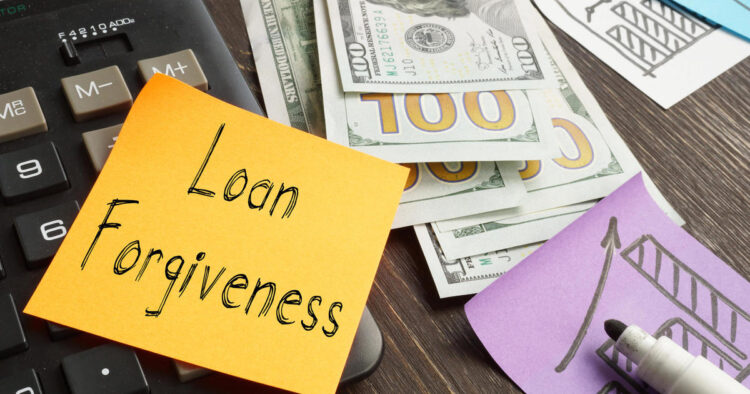Loan forgiveness is shown using a text
Getty Images/iStockphoto
President Biden made a massive student loan debt relief announcement on Wednesday, revealing he's canceling up to $20,000 in student loan debt for millions of Americans. In fact, nearly 20 million people will be eligible to have their debt fully canceled under the new plan, Mr. Biden said.
"An entire generation is now saddled with unsustainable debt in exchange for an attempt at least at a college degree. The burden is so heavy that even if you graduate, you may not have access to the middle-class life that the college degree once provided," said Mr. Biden as he outlined the plan that affects the roughly 43 million federal student loan borrowers. He also extended the student loan payment freeze through the end of the year.
However, this loan forgiveness does not apply to private student loan borrowers who account for an estimated 8% of total outstanding student loan debt in the U.S., according to a 2021 report from MeasureOne. If you fall within this category, then you may want to consider exploring some other ways to save money such as a student loan refinance. See what private lenders have to offer.
Who qualifies for student loan forgiveness?
What to do if you don't qualify for student loan forgiveness?
For those who are federal student loan borrowers, here's how you can apply for debt relief.
How to apply for student loan forgivenessBefore you need to even worry about applying for student loan forgiveness under the Biden administration's new plan, you'll need to make sure you actually qualify. Here are the criteria you need to meet.
- You're a current federal student loan holderYou earn less than $125,000 a year or your household earns less than $250,000 a yearYou're a Pell Grant recipient with loans held by the Department of Education (this is required for additional forgiveness)
If none of the above applies to you or you have a private student loan, then make sure to review what private loan lenders have to offer. A student loan refinance, which essentially means replacing your existing loan with another loan with a potentially more favorable interest rate, is a good option if you're looking to save money long-term. Here's how you can get started.
However, if you check the above boxes, then you are likely eligible for student loan forgiveness under this new plan. Just note that your relief will be capped at the amount outstanding (so you won't get to pocket any extra money if you have less than $10,000 in federal student debt).
Now that you know you meet the qualifications, you'll want to set a reminder to actually apply for the forgiveness. You can sign up to receive a notification from the Department of Education when the application opens.
You will submit an application through the Department of Education, which will outline the exact steps you need to take. You will likely need to demonstrate that you meet the above income threshold and have federal student loan debt, so make sure to gather the appropriate documents to have ready when the application becomes available.
"The application will be available no later than when the pause on federal student loan repayments terminates at the end of the year," the White House said in a statement, adding that 8 million borrowers may be able to automatically get relief because their financial records and income data is already available to the Department of Education.
"Thanks to the American Rescue Plan, this debt relief will not be treated as taxable income for the federal income tax purposes," the White House added.
What is a Pell Grant?While researching the Biden administration's student loan forgiveness plan, you'll come across the term "Pell Grant" a lot. A Pell Grant is a form of financial aid you may be rewarded based on your financial needs, which are determined by the Department of Education during the Free Application for Federal Student Aid (FAFSA) application process.
Your expected income, student status, school-related expenses and more are taken into account. Additionally, your school has to be enrolled in the program. Make sure to contact your school's financial aid office if you'd like more details.
This type of financial aid, which doesn't usually need to be paid back, is reserved for undergraduate students "who display exceptional financial need and have not earned a bachelor's, graduate, or professional degree," according to Federal Student Aid (FSA).
The maximum Pell Grant award for the 2022-23 school year was just under $7,000, FSA states on its website.
"Since 1980, the total cost of both four-year public and four-year private college has nearly tripled, even after accounting for inflation. Federal support has not kept up: Pell Grants once covered nearly 80 percent of the cost of a four-year public college degree for students from working families, but now only cover a third. That has left many students from low- and middle-income families with no choice but to borrow if they want to get a degree," the White House said as they announced their decision on student loan forgiveness, noting that Department of Education data shows undergraduate student on average leave school with nearly $25,000 in debt.
Student loan forgiveness programsFor those interested in receiving student loan forgiveness, you may want to review the following programs that are already made available by the government.
- Teacher Loan ForgivenessPublic Service Loan Forgiveness (PSLF)Income-Driven Repayment (IDR) PlansMilitary ServiceAmeriCorps
Federal Student Aid lists the specific criteria and details you need to know to apply to each.
